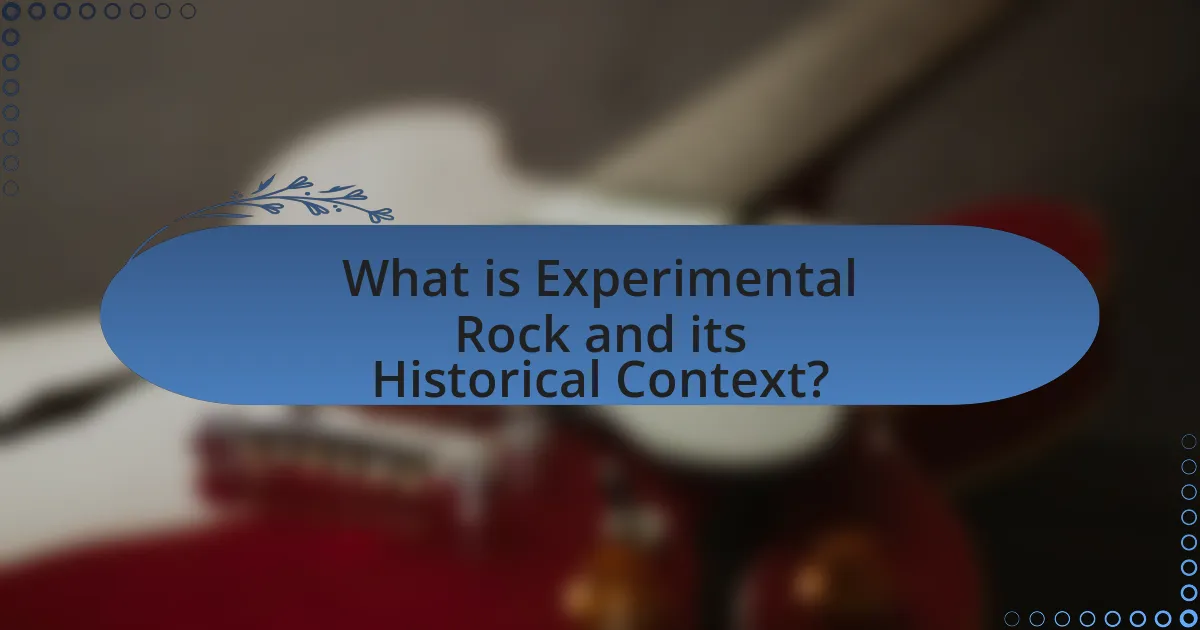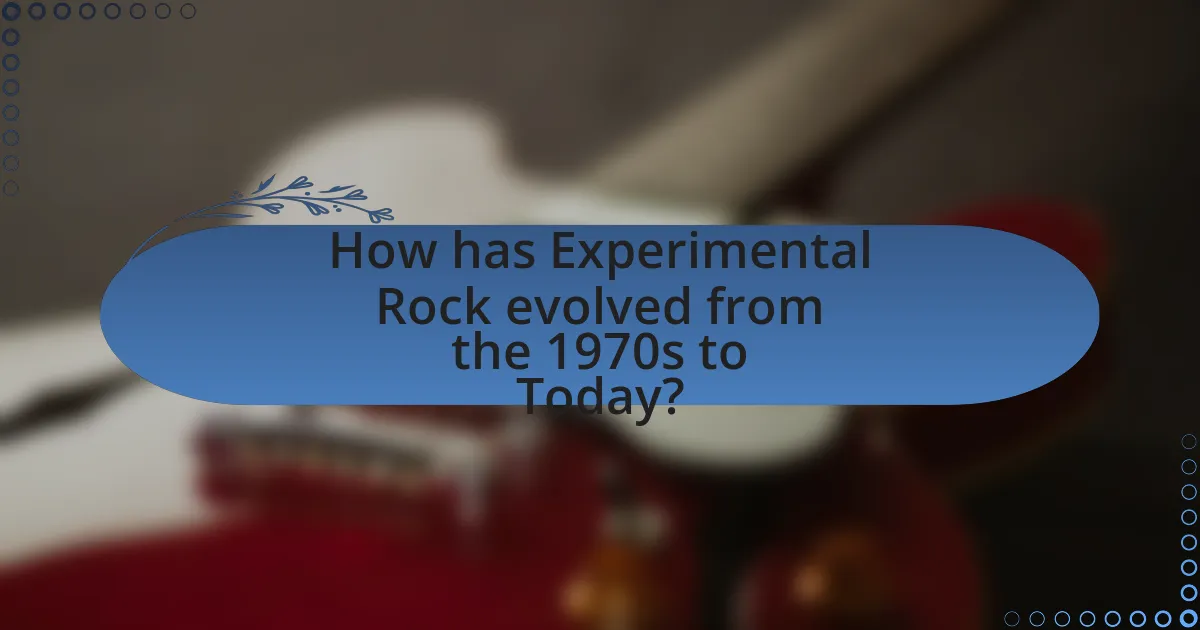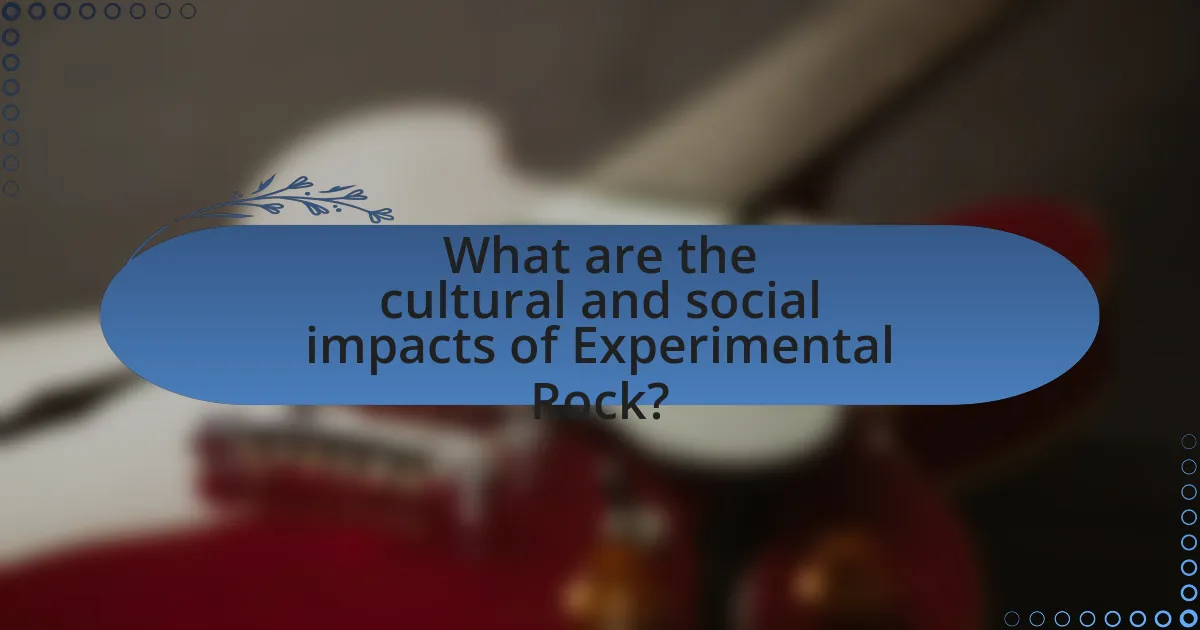Experimental rock is a genre that emerged in the 1960s, characterized by its innovative approach to music, incorporating unconventional sounds, structures, and techniques. Influenced by avant-garde art movements and the counterculture movement, key figures such as The Velvet Underground, Frank Zappa, and Pink Floyd played pivotal roles in shaping the genre. The article explores the historical context of experimental rock, its defining characteristics, and the evolution of the genre from the 1970s to today, highlighting significant artists, technological advancements, and the cultural impacts that have influenced various music styles. Additionally, it examines the lyrical themes, instrumentation, and sound experimentation that define the genre, as well as its ongoing relevance in contemporary music.

What is Experimental Rock and its Historical Context?
Experimental rock is a genre that pushes the boundaries of traditional rock music by incorporating unconventional sounds, structures, and techniques. Emerging in the 1960s, it was influenced by avant-garde art movements, electronic music, and the desire to explore new sonic possibilities. Key figures such as The Velvet Underground and Frank Zappa challenged musical norms, while bands like Pink Floyd and Can integrated elements of psychedelia and improvisation. This genre’s historical context is marked by a cultural shift towards artistic experimentation, reflecting broader societal changes during the counterculture movement of the 1960s. The genre has since evolved, influencing various music styles and continuing to inspire artists seeking to innovate beyond conventional frameworks.
How did the 1960s influence the development of Experimental Rock?
The 1960s significantly influenced the development of Experimental Rock by introducing innovative musical techniques and a culture of artistic exploration. Artists like The Beatles and Frank Zappa began to incorporate unconventional sounds, studio effects, and non-traditional song structures, which laid the groundwork for the genre. The use of electronic instruments, such as the Moog synthesizer, became prominent during this decade, exemplified by albums like The Beatles’ “Sgt. Pepper’s Lonely Hearts Club Band” released in 1967, which showcased a blend of rock with avant-garde elements. Additionally, the counterculture movement encouraged musicians to push boundaries, leading to the emergence of subgenres like psychedelic rock and progressive rock, both of which are integral to Experimental Rock’s evolution.
What key events and movements shaped the genre in the 1960s?
The key events and movements that shaped the genre of experimental rock in the 1960s include the rise of the counterculture movement, the influence of avant-garde art and music, and the technological advancements in recording. The counterculture movement, characterized by a rejection of mainstream values and a quest for new forms of expression, led to the emergence of bands like The Velvet Underground and The Grateful Dead, who pushed musical boundaries. Additionally, the incorporation of avant-garde elements, such as those from John Cage and the Dada movement, inspired artists to experiment with sound and structure. Technological advancements, including the use of multi-track recording and electronic instruments, allowed for greater creativity and innovation in music production, exemplified by albums like The Beatles’ “Sgt. Pepper’s Lonely Hearts Club Band.” These factors collectively contributed to the evolution of experimental rock during the decade.
Who were the pioneering artists and bands in Experimental Rock during this era?
Pioneering artists and bands in Experimental Rock during this era include The Velvet Underground, Frank Zappa, and Pink Floyd. The Velvet Underground, active in the 1960s, is often credited with influencing the genre through their avant-garde approach and incorporation of unconventional themes in their music. Frank Zappa, known for his complex compositions and satirical lyrics, pushed the boundaries of rock music with his innovative techniques and diverse styles. Pink Floyd, particularly with their album “The Piper at the Gates of Dawn,” explored psychedelic sounds and conceptual storytelling, further defining the experimental rock landscape. These artists collectively laid the groundwork for future developments in the genre.
What are the defining characteristics of Experimental Rock?
Experimental Rock is characterized by its innovative approach to music, often incorporating unconventional structures, sounds, and techniques. This genre frequently blends elements from various musical styles, including jazz, electronic, and avant-garde, resulting in a diverse auditory experience. Notable characteristics include the use of non-traditional instruments, extended improvisation, and a focus on texture and atmosphere over melody and rhythm. Historically, bands like The Velvet Underground and Pink Floyd exemplified these traits in the 1960s, pushing the boundaries of rock music and influencing countless artists in subsequent decades.
How do instrumentation and sound experimentation play a role in the genre?
Instrumentation and sound experimentation are fundamental to the genre of experimental rock, as they allow artists to push the boundaries of traditional music structures and create innovative soundscapes. This genre often incorporates unconventional instruments, such as synthesizers, theremins, and found objects, which contribute to its distinctive auditory experience. For instance, the use of tape loops and electronic effects in the works of bands like The Velvet Underground and Pink Floyd exemplifies how sound experimentation can transform musical expression. Additionally, the incorporation of diverse genres and styles, such as jazz, classical, and avant-garde, further enriches the sonic palette, enabling artists to explore new creative avenues. This approach has been pivotal in shaping the genre’s evolution, influencing countless musicians and leading to the emergence of subgenres like post-rock and noise rock.
What lyrical themes are commonly explored in Experimental Rock music?
Experimental Rock music commonly explores themes of existentialism, surrealism, and social commentary. These themes reflect the genre’s inclination to challenge conventional structures and provoke thought. For instance, existentialism is often depicted through lyrics that question the nature of reality and human existence, as seen in works by artists like David Bowie and Pink Floyd. Surrealism manifests in abstract imagery and dream-like narratives, allowing for a departure from linear storytelling, exemplified by the music of Frank Zappa and The Residents. Additionally, social commentary is prevalent, addressing issues such as political unrest and cultural shifts, which can be observed in the lyrics of bands like Sonic Youth and Radiohead. This thematic diversity contributes to the genre’s innovative and boundary-pushing nature.

How has Experimental Rock evolved from the 1970s to Today?
Experimental Rock has evolved significantly from the 1970s to today, transitioning from the avant-garde influences of artists like Frank Zappa and the Velvet Underground to a more diverse and accessible genre that incorporates elements from electronic music, hip-hop, and indie rock. In the 1970s, bands such as King Crimson and Pink Floyd pushed boundaries with complex compositions and innovative soundscapes, laying the groundwork for future experimentation.
By the 1990s and 2000s, artists like Radiohead and The Mars Volta began to blend traditional rock structures with electronic elements and unconventional song formats, reflecting a shift towards a more eclectic approach. Today, experimental rock continues to thrive, with artists like Björk and Animal Collective exploring new technologies and genres, demonstrating the genre’s adaptability and ongoing relevance in the music landscape. This evolution showcases a continuous dialogue between past influences and contemporary innovations, solidifying experimental rock’s place in modern music.
What major shifts occurred in the genre during the 1970s and 1980s?
During the 1970s and 1980s, experimental rock underwent significant shifts characterized by the incorporation of diverse musical influences and the emergence of new subgenres. The genre expanded beyond traditional rock structures, integrating elements from electronic music, punk, and world music, which led to the development of styles such as post-punk and new wave. Notable bands like Kraftwerk and Talking Heads exemplified this evolution by blending technology with rock, while artists like David Bowie and Brian Eno pushed the boundaries of sound and production techniques. These changes reflected a broader cultural shift towards innovation and experimentation in music, marking a departure from the more straightforward rock of the previous decades.
How did technology influence the sound and production of Experimental Rock?
Technology significantly influenced the sound and production of Experimental Rock by enabling innovative recording techniques and the use of electronic instruments. The introduction of multi-track recording in the 1960s allowed artists like The Beatles and Pink Floyd to layer sounds and create complex compositions, which became a hallmark of the genre. Additionally, the development of synthesizers and effects pedals expanded the sonic palette, allowing musicians to explore new textures and soundscapes. For instance, the Moog synthesizer, popularized in the late 1960s, provided unique sounds that were previously unattainable, fundamentally altering the musical landscape. These technological advancements not only shaped the production methods but also encouraged a culture of experimentation, leading to the diverse and avant-garde nature of Experimental Rock.
What new subgenres emerged from Experimental Rock in this period?
New subgenres that emerged from Experimental Rock during this period include Post-Rock, Math Rock, and Shoegaze. Post-Rock, characterized by its use of non-traditional rock instrumentation and a focus on atmosphere, gained prominence in the 1990s with bands like Tortoise and Sigur Rós. Math Rock, known for its complex time signatures and intricate guitar work, was exemplified by bands such as Don Caballero and Battles. Shoegaze, which blends ethereal vocals with heavy guitar effects, was popularized by groups like My Bloody Valentine and Slowdive in the late 1980s and early 1990s. These subgenres reflect the innovative spirit of Experimental Rock and its influence on the broader music landscape.
What role do contemporary artists play in the evolution of Experimental Rock?
Contemporary artists play a crucial role in the evolution of Experimental Rock by pushing the boundaries of sound, structure, and genre. They incorporate diverse influences, such as electronic music, avant-garde techniques, and global musical traditions, which expand the sonic palette of the genre. For instance, artists like Flying Lotus and Björk blend elements of jazz, hip-hop, and classical music, creating innovative compositions that challenge traditional rock norms. This fusion not only revitalizes the genre but also attracts new audiences, ensuring its relevance in the modern music landscape. Furthermore, contemporary artists often utilize technology and multimedia in their performances, enhancing the overall experience and further evolving the genre’s artistic expression.
How are modern influences reshaping the genre today?
Modern influences are reshaping the experimental rock genre by integrating diverse musical styles and advanced technology. Artists today are blending elements from genres such as electronic, hip-hop, and world music, which expands the sonic palette and encourages innovation. For instance, the use of digital production techniques and software allows for intricate sound manipulation, as seen in the works of contemporary bands like Radiohead and Tame Impala, who incorporate electronic sounds into their rock compositions. This fusion not only attracts a broader audience but also challenges traditional rock structures, leading to a more fluid and dynamic genre.
What are some notable contemporary Experimental Rock artists and their contributions?
Notable contemporary Experimental Rock artists include Radiohead, Björk, and Animal Collective, each contributing significantly to the genre. Radiohead has pushed boundaries with their innovative use of technology and soundscapes, particularly in albums like “Kid A,” which incorporated electronic elements and unconventional song structures. Björk is known for her eclectic style and incorporation of various genres, utilizing unique instrumentation and production techniques in albums such as “Vespertine,” which blends orchestral and electronic music. Animal Collective has contributed to the genre with their experimental approach to melody and rhythm, particularly in “Merriweather Post Pavilion,” which features layered harmonies and a blend of acoustic and electronic sounds. These artists exemplify the evolution of Experimental Rock by integrating diverse influences and challenging traditional musical norms.

What are the cultural and social impacts of Experimental Rock?
Experimental Rock significantly influences cultural and social dynamics by challenging conventional music norms and fostering artistic innovation. This genre emerged in the 1960s, with bands like The Velvet Underground and Pink Floyd pushing boundaries, which encouraged a broader acceptance of diverse musical styles and themes. The incorporation of avant-garde elements, such as electronic sounds and unconventional song structures, has inspired subsequent genres, including punk, metal, and electronic music, thereby reshaping the musical landscape.
Moreover, Experimental Rock has served as a platform for social commentary, addressing issues such as politics, identity, and existentialism. For instance, the album “The Dark Side of the Moon” by Pink Floyd explores themes of mental health and societal pressures, resonating with listeners and prompting discussions around these topics. This genre’s emphasis on artistic expression has also led to the emergence of subcultures that value creativity and nonconformity, further impacting societal norms and values.
In summary, the cultural and social impacts of Experimental Rock are evident in its role as a catalyst for musical innovation and its ability to provoke critical conversations about societal issues.
How has Experimental Rock influenced other music genres?
Experimental Rock has significantly influenced various music genres by introducing innovative sounds, structures, and concepts. This genre has paved the way for the development of Progressive Rock, Post-Rock, and even Electronic music, as artists began to incorporate unconventional instrumentation and complex arrangements. For instance, bands like Pink Floyd and The Velvet Underground utilized experimental techniques that inspired the emergence of alternative and indie rock movements in the 1980s and 1990s. Additionally, the use of studio technology and sound manipulation in Experimental Rock has directly impacted genres such as Hip-Hop and Pop, where sampling and electronic production techniques became prevalent. The legacy of Experimental Rock is evident in the works of contemporary artists who continue to push musical boundaries, demonstrating its lasting influence across the music landscape.
What cross-genre collaborations have emerged from Experimental Rock?
Cross-genre collaborations that have emerged from Experimental Rock include notable partnerships such as David Bowie and Brian Eno, which resulted in the influential “Berlin Trilogy” albums, blending rock with electronic music. Another significant collaboration is between Radiohead and producer Nigel Godrich, which has incorporated elements of electronic, jazz, and classical music into their rock foundation. Additionally, the collaboration between the band The Mars Volta and various artists, including John Frusciante, showcases a fusion of progressive rock, jazz, and Latin influences. These collaborations illustrate how Experimental Rock has transcended traditional genre boundaries, leading to innovative musical expressions.
How does Experimental Rock reflect societal changes and movements?
Experimental Rock reflects societal changes and movements by serving as a sonic representation of cultural shifts and political sentiments. This genre emerged in the 1960s, a period marked by significant social upheaval, including the civil rights movement and anti-war protests, which influenced artists like Frank Zappa and The Velvet Underground to challenge conventional music norms and address societal issues through their work. The incorporation of unconventional sounds and structures in Experimental Rock mirrors the desire for innovation and rebellion against the status quo, reflecting the counterculture’s quest for identity and expression. For instance, the album “Sgt. Pepper’s Lonely Hearts Club Band” by The Beatles not only showcased musical experimentation but also encapsulated the spirit of the 1960s, addressing themes of peace and love amidst a backdrop of societal turmoil. Thus, Experimental Rock acts as both a reflection and a catalyst for societal change, capturing the zeitgeist of its time through its avant-garde approach.
What can listeners learn from the evolution of Experimental Rock?
Listeners can learn about the innovative spirit and genre-blending nature of Experimental Rock through its evolution. This genre emerged in the 1960s, characterized by artists like The Velvet Underground and Frank Zappa, who pushed musical boundaries by incorporating unconventional sounds and structures. The evolution showcases how artists have continuously challenged traditional norms, leading to diverse subgenres and influences, such as electronic music and punk. For instance, the incorporation of avant-garde techniques by bands like Radiohead in the 1990s illustrates the ongoing experimentation that defines the genre. This historical context highlights the importance of creativity and the willingness to explore new artistic avenues in music.
How can understanding the genre enhance appreciation for music as a whole?
Understanding the genre enhances appreciation for music as a whole by providing context and insight into the cultural, historical, and artistic influences that shape musical styles. For instance, recognizing the roots of experimental rock in the 1960s, such as its connections to avant-garde art movements and social upheaval, allows listeners to grasp the innovative techniques and thematic explorations that define the genre. This deeper comprehension fosters a greater emotional connection and critical engagement with the music, as listeners can appreciate the complexities and intentions behind the sounds and lyrics. Studies have shown that genre awareness can significantly influence listener enjoyment and interpretation, highlighting the importance of context in musical appreciation.
What are some tips for exploring and enjoying Experimental Rock music?
To explore and enjoy Experimental Rock music, start by listening to a diverse range of artists and albums within the genre, such as The Velvet Underground, Sonic Youth, and Radiohead, as they showcase the genre’s innovative soundscapes. Engaging with live performances can enhance the experience, as many Experimental Rock bands emphasize improvisation and unique stage presence, which can be transformative. Additionally, reading about the historical context and influences of the genre, including its roots in the 1960s counterculture, can provide deeper appreciation and understanding. Listening to curated playlists or radio stations dedicated to Experimental Rock can also introduce listeners to lesser-known artists and tracks, enriching their exploration.